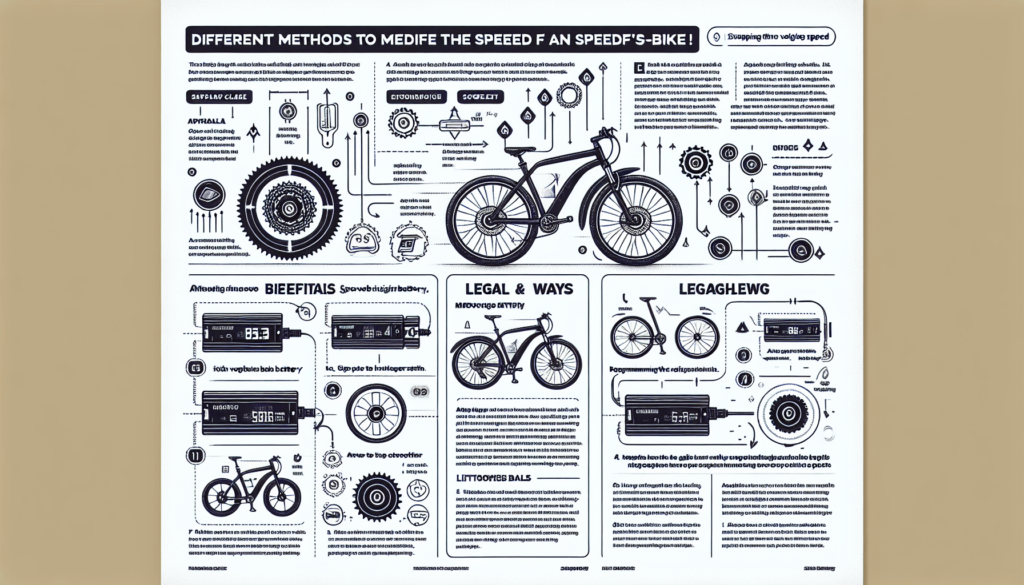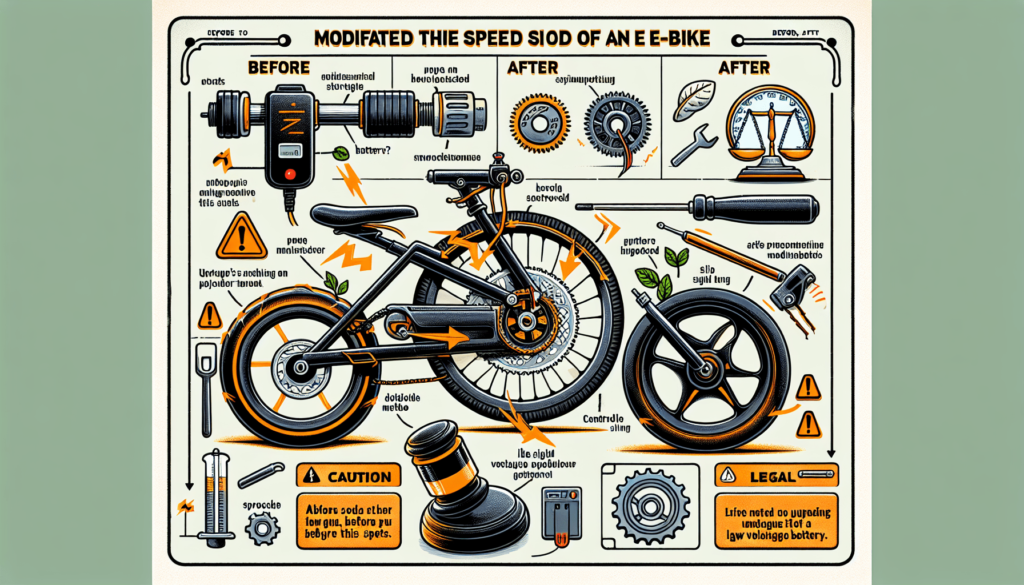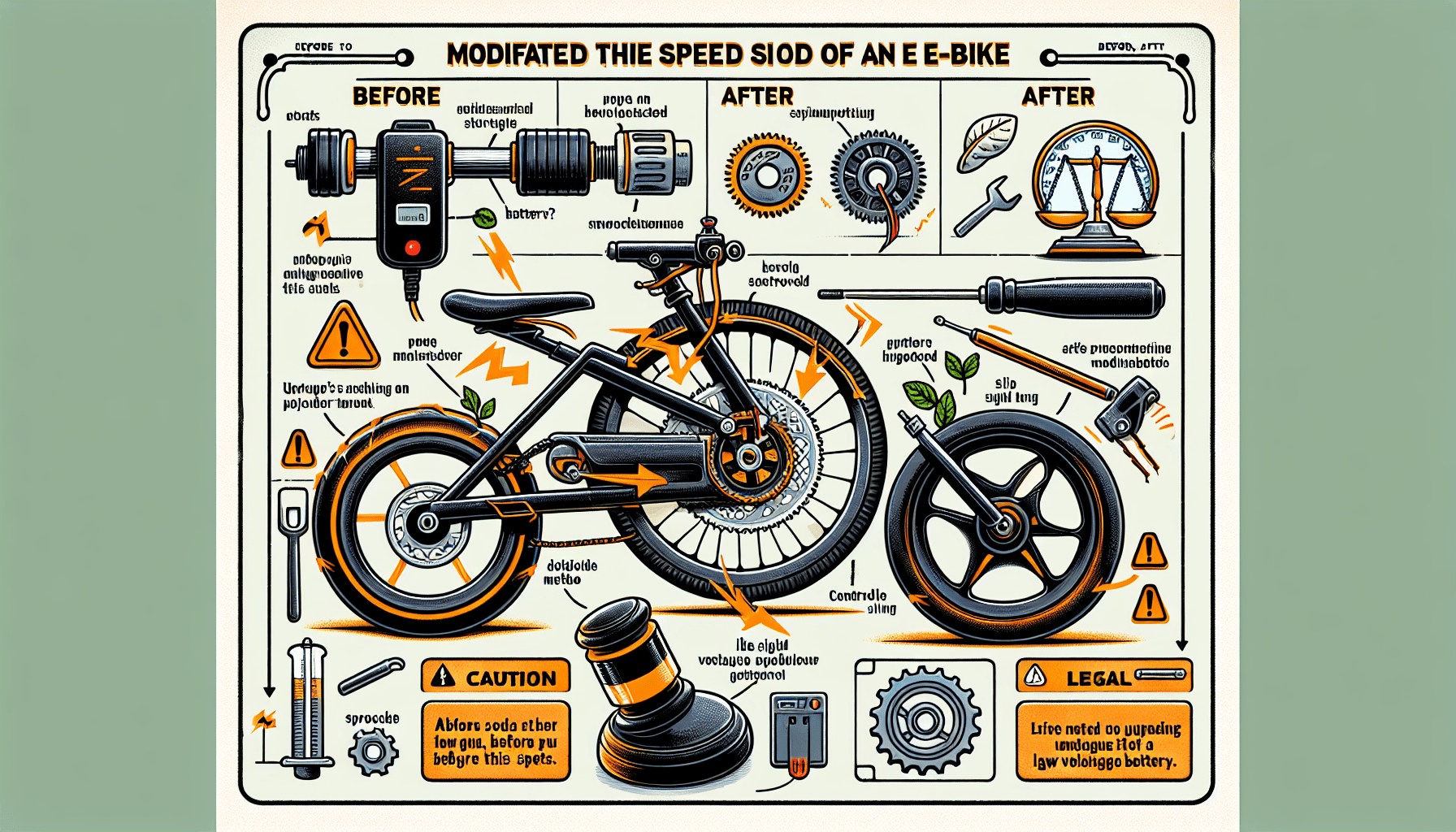So you’re wondering if you can modify the speed of your e-bike? Well, the answer is yes, you can! If you feel like your e-bike is not reaching the desired speed or you simply want to have a little more zip in your rides, there are several ways you can go about modifying the speed of your e-bike. From upgrading the motor and battery to adjusting the controller settings, there are options available to suit your needs and preferences. In this article, we will explore some of the methods you can use to modify the speed of your e-bike and help you unlock a faster and more exhilarating riding experience. Get ready to hit the road with an extra boost!
Understanding E-bike Speed Limits
What is an e-bike?
An e-bike, short for electric bike, is a bicycle that is equipped with an electric motor to assist the rider’s pedaling. It combines the advantages of a traditional bicycle with the convenience and efficiency of electric power. E-bikes are becoming increasingly popular due to their ability to provide a smoother and easier ride, especially when it comes to tackling hills and longer distances.
What are the speed limits for e-bikes?
The speed limits for e-bikes vary depending on the country and its regulations. In most countries, e-bikes are limited to a top speed of 20 to 28 mph (32 to 45 km/h). However, it’s important to note that some regions have different speed limits for different classes of e-bikes. For instance, in the United States, Class 1 and Class 2 e-bikes are limited to a top speed of 20 mph (32 km/h), while Class 3 e-bikes can reach up to 28 mph (45 km/h).
Why are there speed limits on e-bikes?
Speed limits on e-bikes are in place for various reasons. Firstly, they help ensure the safety of riders and others sharing the road or bike paths. High speeds can increase the risk of accidents and make it harder for riders to react to unexpected situations. Additionally, speed limits help regulate traffic flow and prevent e-bikes from being used at speeds that could pose a danger to pedestrians or slower cyclists. Setting speed limits also allows for consistent enforcement of regulations and ensures that e-bikes are operated in a manner that aligns with other vehicles on the road.
Factors Affecting E-bike Speed
Motor power
The power of the electric motor plays a significant role in determining the speed of an e-bike. The higher the motor power, typically measured in watts, the faster the e-bike can go. Different e-bikes come with varied motor power options, ranging from 250 watts for personal use to over 1000 watts for more powerful electric bicycles used for off-road purposes. It’s important to note that the motor power alone does not determine the top speed of an e-bike, as other factors also play a role.
Battery capacity
The battery capacity of an e-bike is another crucial factor that affects its speed. The battery supplies the electric motor with the necessary power, and a larger capacity battery can sustain higher speeds for a longer period. E-bikes with bigger and more advanced batteries can provide a greater range and withstand higher power demands, resulting in increased speeds. It’s worth noting that battery capacity works in conjunction with other factors, such as motor power and terrain, to determine the e-bike’s overall performance.
Terrain and elevation
The terrain and elevation on which an e-bike is being ridden can significantly impact its speed. Riding on flat surfaces or downhill will allow the e-bike to reach and sustain higher speeds more easily. Conversely, uphill climbs or rough terrain will require the e-bike to work harder to maintain speed. It’s important to consider the type of terrain you’ll be riding on, as it can affect the overall performance and speed capabilities of your e-bike.
Weight of the rider and cargo
The weight of the rider and any additional cargo carried on the e-bike can affect its speed. More weight requires the motor to work harder to propel the e-bike forward, potentially reducing its overall speed. Similarly, carrying heavy loads can also impact the e-bike’s acceleration and top speed. It’s essential to keep in mind the weight limitations specified by the manufacturer to ensure optimal performance and prevent any strain on the motor or battery.

Legalities of Modifying E-bike Speed
Laws and regulations regarding e-bike modifications
Modifying the speed of an e-bike is subject to laws and regulations that vary by jurisdiction. It’s essential to familiarize yourself with the specific regulations in your area before making any modifications. In some regions, modifications that result in an e-bike exceeding the legal speed limits may render the vehicle illegal to ride on public roads or bike paths. It’s crucial to understand the specific guidelines regarding e-bike modifications to ensure compliance with the law and avoid any potential penalties or fines.
Consequences for illegal modifications
Illegal modifications to an e-bike’s speed can have severe consequences. If caught riding an e-bike that has been modified to exceed legal speed limits, you may face legal repercussions, such as fines, license suspensions, or even confiscation of the e-bike. Moreover, insurance coverage may be voided in the event of an accident if the e-bike has been unlawfully modified. Therefore, it’s crucial to abide by the legal restrictions and consider the potential implications before attempting any modifications that would render the e-bike non-compliant.
Types of E-bike Speed Modification
Software-based modifications
Software-based modifications involve altering the settings and parameters of the e-bike’s existing software to increase its speed capabilities. These modifications are often done through the manufacturer’s software or third-party software options. Software-based modifications can be a more straightforward and less invasive way to adjust the e-bike’s speed, as they don’t typically require physical changes to the hardware components. However, it’s important to note that not all e-bike models allow for software modifications, and making changes through unauthorized software may void the warranty.
Hardware-based modifications
Hardware-based modifications involve physically upgrading the e-bike’s components to enhance its speed. This can include replacing the existing motor with a more powerful one or upgrading the battery for increased capacity and output. Hardware modifications often require technical expertise or assistance from professionals to ensure that the changes are done safely and effectively. It’s crucial to consider the compatibility of the components and the potential impact on the e-bike’s overall performance before proceeding with hardware-based modifications.
Combination of software and hardware modifications
Some e-bike enthusiasts opt for a combination of software and hardware modifications to achieve the desired increase in speed. This approach allows for a more comprehensive enhancement of the e-bike’s performance. By utilizing software adjustments and upgrading specific hardware components, riders can customize their e-bike to better suit their needs. However, it’s important to note that combining software and hardware modifications may require more technical knowledge and can be more costly than individual modifications.

Software-based E-bike Speed Modifications
Using the manufacturer’s software
Some e-bike manufacturers provide software tools that allow riders to adjust certain parameters, including speed limits. These software options are often designed to ensure that the modifications stay within legal limits and maintain the e-bike’s optimal performance. Before using the manufacturer’s software, it’s essential to familiarize yourself with the specific instructions and restrictions to ensure a safe and lawful modification. Keep in mind that using unauthorized software or making changes outside of the manufacturer’s guidelines may void the warranty.
Third-party software options
In addition to manufacturer-provided software, there are also third-party software options available for modifying e-bike speed. These software tools offer greater flexibility and customization options, but it’s crucial to exercise caution when using them. Ensure that the third-party software is reputable, compatible with your e-bike model, and abides by the legal restrictions. Before making any modifications, thoroughly research the software and follow the instructions provided to minimize the risk of voiding the warranty or engaging in illegal practices.
Hardware-based E-bike Speed Modifications
Upgrading the motor
One of the significant hardware modifications that can increase e-bike speed is upgrading the motor. By replacing the existing motor with a more powerful one, riders can experience higher speeds and improved performance. However, it’s important to consider the compatibility of the new motor with the e-bike’s existing components and ensure that it doesn’t exceed legal speed limits. Upgrading the motor may require professional assistance to ensure proper installation and avoid any potential damage to the e-bike.
Upgrading the battery
Another hardware modification to consider for increasing e-bike speed is upgrading the battery. A higher-capacity battery can provide increased power output and extend the range of the e-bike. However, it’s crucial to note that installing a larger capacity battery may affect the e-bike’s weight and balance, potentially impacting its handling and stability. Additionally, the compatibility of the new battery with the e-bike’s charging system and motor should be carefully considered before making any modifications.
Combination of Software and Hardware Modifications
Using software and hardware upgrades together
Combining software modifications with hardware upgrades can offer the best of both worlds when it comes to enhancing e-bike speed. By adjusting the e-bike’s software settings and upgrading key hardware components, riders can achieve a customized and optimized speed improvement. However, it’s important to carefully research and plan the modifications to ensure compatibility, maintain compliance with legal restrictions, and avoid any potential negative impact on the e-bike’s safety and reliability.
Benefits and considerations
The combination of software and hardware modifications can offer several benefits. Riders can enjoy increased speeds, improved performance, and a more tailored riding experience. By using authorized software and selecting compatible hardware upgrades, the e-bike’s warranty may also remain intact. However, it’s important to consider the costs associated with these modifications, including both the financial investment and potential risks. Technical expertise and professional assistance may be necessary, particularly with complex modifications, to ensure safety and reliability.
Safety Considerations
Keeping within legal speed limits
While it may be tempting to modify your e-bike speed to go faster, it’s crucial to prioritize safety and comply with legal speed limits. Exceeding the prescribed limits can increase the risk of accidents and jeopardize your safety and the safety of others. It’s important to understand and respect the specific regulations in your jurisdiction to ensure responsible and lawful e-bike usage. Remember that the primary purpose of e-bike speed limits is to maintain safety and harmony on the roads.
Using protective gear
Regardless of whether you have modified your e-bike’s speed or not, it’s essential to prioritize safety by using appropriate protective gear. Wearing a helmet, reflective clothing, and other safety gear can significantly reduce the risk of injuries in the event of an accident or sudden stop. It’s also advisable to use lights and reflective elements to enhance visibility, particularly during low-light conditions. By taking these precautions, you can ride confidently and minimize the potential consequences of any accidents or mishaps.
Regular maintenance and inspection
Modifying your e-bike’s speed may expose it to increased stress and demands. Therefore, it’s crucial to perform regular maintenance and inspections to ensure the e-bike’s safety and reliability. Regularly check the brakes, tires, electrical connections, and other components for signs of wear or damage. Follow the manufacturer’s recommended maintenance schedule and consult a professional if you’re unsure about any aspects of your modified e-bike. By keeping your e-bike in good condition, you can enjoy a safe and trouble-free riding experience.
Implications of Modifying E-bike Speed
Effect on warranty
Modifying the speed of your e-bike may affect its warranty. Manufacturers typically do not endorse unauthorized modifications, and altering the software or hardware components of the e-bike may void the warranty. It’s crucial to review the terms and conditions of your e-bike’s warranty and consult with the manufacturer or an authorized dealer before making any modifications. If your e-bike is still under warranty, it may be advisable to consider whether the potential increase in speed outweighs the risk of voiding the warranty.
Insurance coverage
Modifying an e-bike’s speed can also impact your insurance coverage. Insurance providers usually require that the e-bike be used legally and within its original specifications. If the e-bike has been modified to exceed legal speed limits, it may be considered non-compliant, and your insurance coverage may be voided. It’s important to check with your insurance provider to understand the specific implications of e-bike modifications on your coverage and ensure that you remain adequately protected.
Safety and reliability
Modifying your e-bike speed can potentially impact its safety and reliability. Any modifications, whether software-based or hardware-based, should be done carefully and with consideration for the e-bike’s overall performance. Incompatibility, poor installation, or improper adjustments can compromise the e-bike’s handling, stability, and braking capabilities. It’s crucial to prioritize safety and reliability when making any modifications, and if in doubt, consult professionals or authorized dealers who can provide guidance and ensure the modifications are done correctly.
Conclusion
Understanding the options and risks of modifying e-bike speed is essential for any e-bike enthusiast. While it may be tempting to seek higher speeds, it’s important to prioritize safety and compliance with legal regulations. Speed limits are in place to ensure the safety of riders, pedestrians, and other road users. If you are considering modifying your e-bike’s speed, carefully evaluate the available options, and ensure that any modifications comply with the law and maintain the e-bike’s safety and reliability. Remember that a responsible and well-maintained e-bike can provide an enjoyable riding experience while keeping you and others safe on the road.

